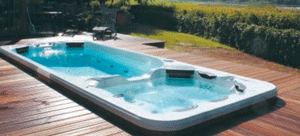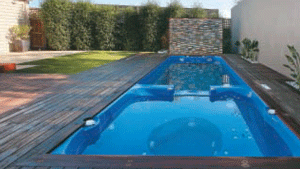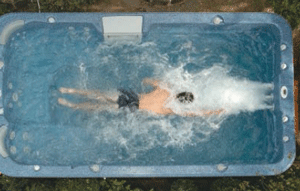
Words: Rachel Falzon
Living in a small space can have its limitations when you want a body of water to use for exercise; you’re not going to have an effective or enjoyable workout if you have to change direction after every couple of arm lengths. Perhaps you do have a large backyard but you just don’t have time for the upkeep a pool requires, or you’re looking for an entertaining option that can be used throughout the year. A swim spa could be just the solution.
A swim spa is just as its name implies: a spa you can swim in. Created in the 1980s, they offer the ability to swim or relax thanks to resistance created by counter-swim surf jets.
The swim spa benefits
Whatever your outdoor area comprises, there’s a swim spa to suit. There are portable designs that look similar to a regular portable spa with their cedar housing cabinet. Alternatively, swim spas can be installed in the ground or into a deck or patio so, no matter how small the outdoor space, you’re sure to be able to find one to fit. If you would prefer to place your swim spa indoors, be sure to check that the floor can support the weight of the spa.
According to Rachel Anderson from Endless Spas, swim spas are used by families, professional swimmers and those looking to improve their fitness as well as for entertaining friends and family members.
The versatility of swim spas lies in their application. They can be used for exercise and swimming as well as for their therapeutic properties. Water is taken from the pool and pumped through the jet streams, producing a concentrated flow of water that’s suitable for either swimming or walking. You can set the water pressure to accommodate your needs — whether a child is learning to swim or an adult is training for a serious swim meet, everyone is catered for.
If you’ve had a stressful day at the office or are suffering from aches and pains, spas are renowned for being able to help with the alleviation of these problems. When used in this way, the jets, along with the bubbles created by aeration, massage the body. While all spas with jets are classified as having hydrotherapy jets (hydrotherapy jets are water massage jets used in hot water), Rachel says the more jets you have the greater the massage and therapeutic benefits.
Choice of sizes and style
Swim spas are available in large and small sizes and can accommodate more than 10 people when used for relaxing when entertaining friends and family. What better way to spend a Sunday afternoon than sipping a cocktail in the spa? It won’t matter if the weather is dreary or hot, as the water temperature is adjustable and, if located under a roof such as an awning or separate structure, the spa is usable even in wet conditions.
The heating option makes swim spas usable all year round. And, because spas are generally smaller than the average family pool, the cost to do so is minimised.
“Compared to a traditional pool of 60,000 litres or more, a swim spa uses less than 8000 litres,” explains Rachel. You can choose to heat your spa via electricity or gas, offering flexibility to be compatible with your home’s power sources.
Just as you can with swimming pools, you can opt for saltwater over chlorine. This sanitising solution is efficient, effective, cheap to run and maintain, a natural healing agent and great for sensitive skin and allergy sufferers. It also has a more pleasant odour than chlorine.
Practical issue to consider
Rachel explains there are a few things to consider before heading out to buy a swim spa. First and foremost, think about where you want to locate the spa. This will determine your limitations when it comes to above- or in-ground models. Above-ground models have the advantage of being portable, which means you can take them with you if you move. An in-ground model offers more design possibilities, as you can integrate it into the landscape to make it look similar to a pool by tiling or landscaping right to the edge.
“Fencing and permits are required,” warns Rachel, so be sure to check with your council to find out what you need to do to ensure your swim spa is both safe and approved.
“Think about why you have decided to buy a swim spa,” says Rachel. “Consider the reason and purpose. There are many models on the market with different designs; some have more seats than others and some are better for swimming (they have larger swim areas, depths and better-quality swim jets). Others have more swim jets, which will provide greater therapeutic massage.”
When it comes to the cost of running a swim spa, Rachel says they’re not particularly expensive. “However, to reduce the cost of heating it, Endless Spas does recommend upgrading to gas heating if you live in a cool climate and, for the hotter areas such as Queensland, install solar heating. Heat pumps also work well to minimise running costs,” she explains.
Co-ordinating a cohesive look
Of course, style and colour will be important considerations when looking at integrating a swim spa into your landscape. Think about the colour scheme you already have and, if you have a pool, what colour has been used for its interior. In-ground spas alleviate the worry of choosing housing. Generally, for those buying an above-ground swim spa, there are cedar-clad versions and steel-framed models. If you’re planning to move and want to take the spa with you, choose colours and housing that are likely to suit a variety of settings. Colours will vary from one manufacturer to another but generally the options are much the same as regular spas.
Whatever your location, a swim spa is a great addition to the landscape. Offering flexibility in style, use and functionality, it will be a great and much-used investment in your outdoor area.
Spa maintenance
- Changing the water: The spa water should be changed every three to four months, or remove and replace about one-third of the volume of water every three to four weeks.
- Total alkalinity: The total alkalinity should be in the range of 90–150ppm (parts per million). A spa or hot tub with low total alkalinity would require constant adjustment of the pH. To raise total alkalinity, add sodium bicarbonate in small quantities. To lower the total alkalinity, add acid (hydrochloric acid) in small quantities. Test in one hour.
- The pH level: pH is the measure of the acid/alkaline level of the water. It is important to maintain the correct pH level as it affects the action of other chemicals. The pH is measured on a scale of 1 to 14, with 7 being neutral, below 7 acidic and above 7 is alkaline. Incorrect pH levels can cause poor chlorine or bromine efficiency, eye and skin irritations, corrosion of metal fittings, cloudy water and formation of scale on the pool walls and fittings. The pH should always be above 7 (measured at room temperature, not hot) to avoid possible corrosion of equipment. However, it should not be higher than 7.8, as this would reduce the efficiency of the sanitiser. If the pH level needs to be increased, add soda ash; to reduce the pH level, add acid. Wait for one hour and test again.
- Sanitising the spa: Sanitising your spa is essential for safe, healthy water, free of harmful micro-organisms. The most common forms of sanitiser are chlorine and bromine. Ozone may also be used, but because there can be no residual, chlorine or bromine must be used in conjunction with it. Saltwater chlorinators must be of sufficient capacity to maintain the recommended chlorine residual. The amount of disinfectant required depends on a number of factors, including water temperature, the frequency of use and the number of people using the spa. It’s most important to always keep the sanitiser level at 2–3ppm. In very hot water the sanitiser can be used up very quickly and should be checked








